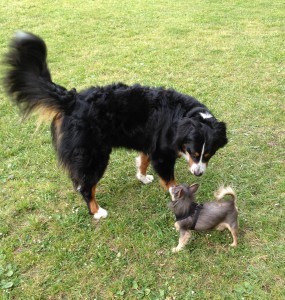My dog Gustav is a master of communicating succinctly, specifically and generously.
His simple, direct messages are easy for me to track and understand—especially since Gustav has trained me to observe and respond to his requests.
Is this a dilemma?
Not in the era of bio-empathy, which is the ability to see things from nature’s point of view and to understand, respect and learn from its patterns.
Bio-empathy is one of 10 new leadership skills needed for our VUCA (volatile, uncertain, complex and ambiguous) world, according to Bob Johansen, the Distinguished Fellow with the Institute for the Future (IFTF).
As described in his latest book Leaders Make the Future, bio-empathy helps leaders take a long-term view and be resilient, as well as improve their person-to-person communication. Johansen says dogs are great teachers of bio-empathy.
Gustav’s communication style has created an unintended consequence. Gustav, pictured left with his friend Julio, has so spoiled me with his clear signals that I crave them from others, including humans. And I find I get frustrated when I have to expend energy deciphering what should be straightforward human messages, especially email.
Granted, Gustav and I have one big advantage in that all of our communication takes place face-to-face—which is becoming rare yet valued in many workplaces.
Nodding heads and pointing—Gustav with his nose and me with my arms, hands and fingers—only works when you can see one another. Yet, these methods are extremely efficient and effective. For example, just a few small movements and you can agree on where you’re walking.
Now contrast this with some of the human emails I receive about work projects. The most challenging are the walls of words. These messages are densely packed with run-on sentences, more pronouns than proper names and no clear calls to action.
To figure out the point of these messages, I have to read them several times and hope I don’t come down with MEGO (my eyes glaze over).
Sometimes I wonder which is worse—not being green and printing out a message so I can try to diagram it or taking more time online to see if I can figure it out. Both actions are wasteful, especially since I try to practice lean office principles.
Then there’s the additional time needed to go back and forth to clarify what the person is trying to tell me and determine what I’m to do next.
In a few cases, I’ve decided it’s best to wean myself from these situations, and if at all possible, not work with these individuals again once our project ends. It may be mean, but it’s also an act of self-preservation.
Remember the prison warden in the classic movie Cool Hand Luke? “What we’ve got here is failure to communicate.” And as the warden noted, some people you just can’t reach.
And whether you can teach them is also questionable. In the spirit of bio-empathy, you can try to encourage others to listen, observe and appreciate nature. This includes balancing between living in the moment—as dogs do so well—and acknowledging the long-term cycles of life.
As for me, put me in with a pack of dogs. We can teach each other, and even better fully enjoy each other’s company.
Want to practice bio-empathy and join our pack?


0 Comments